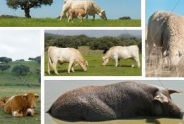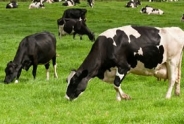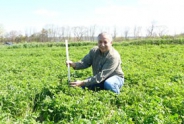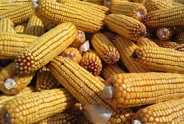Dairy
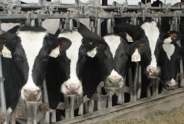 Dairy is the leading agricultural industry in New York State, and the state ranks third in the country for milk production. Our ten counties in western New York form an especially vibrant dairy region, with 943 dairy farms of many different sizes and production systems. Wyoming county is the top milk producing county in the state, producing 1.1 billion pounds annually.
Dairy is the leading agricultural industry in New York State, and the state ranks third in the country for milk production. Our ten counties in western New York form an especially vibrant dairy region, with 943 dairy farms of many different sizes and production systems. Wyoming county is the top milk producing county in the state, producing 1.1 billion pounds annually.DAIRY CATEGORIES
Growing Great People Workshop Interview on Finger Lakes Radio
Donette Griffith, Administrative Assistant
South Central New York Dairy & Field Crops
Coronavirus Food Assistance Program (CFAP)
On April 18, Dr. Andrew Novakovic, recently retired but formerly the Director of the Cornell Dairy and Markets Policy Program, sent an update on financial assistance provided by the federal government through the Coronavirus Food Assistance Program (CFAP), including an overview of the program and estimates of the direct payments dairy farmers might receive.
USDA's Latest Dairy Forecast
April 13, 2020 - USDA's official, consensus forecast for agricultural markets, known as the World Agricultural Supply and Demand Estimates (WASDE) report, just came out. Their analysis of dairy market (as of early April) is as follows:
2018 Feed Dealer Seminars
Tatum Langworthy, Sr. Administrative Assistant
South Central New York Dairy & Field Crops
First Cutting Updates - Week of May 22nd, 2018
Betsy Hicks, Area Dairy Specialist
South Central New York Dairy & Field Crops
An overall assessment of first cutting growth from fields we measured:
Quite a few farms across the region have started harvest of pure grass stands, as well as mixed stands. Recommendations are for 50% or less alfalfa stands to make prudent use of this cutting window to harvest for peak dairy quality across the region. There is still time for pure alfalfa stands to gain yield, given Jerry Cherney's observations. Look for our final report on Wednesday, May 30th. We will be sending out a brief survey of how you use the reports, so please feel free to give your assessment of how we are doing in regards to timing of first crop. You can also reply to Betsy with any comments you may have on the use of the report or how we can improve.
In the meanwhile, stay safe out in the fields and update the team with any conditions you encounter that would be of interest.
First Cutting Updates - Week of May 29, 2018
Betsy Hicks, Area Dairy Specialist
South Central New York Dairy & Field Crops
An overall assessment of first cutting progress from fields we measured: Most fields we measure have been harvested or are in the process of being cut. Early samples we've gotten back have shown that grass cut on recommendations looks really nice. One all grass sampled showed Adj Prot 22.0%, NDF 53.2 and NDFD 30h at 76. Early grass varieties are well headed by now, but later maturing grasses are just to head stage. If you have alfalfa fields standing alongside grass fields, it may be a good idea to harvest the grass for heifer or dry cow haylage, and focus on getting your alfalfa crop for lactating quality. Most alfalfa fields still standing are showing signs of early bud. A sample we've gotten back on a mostly alfalfa field cut on recommendations showed Adj Prot 22.6%, NDF of 48 and NDFD at 66, with the NDF and NDFD numbers a bit surprising. We'd like to see more samples of both grass and alfalfa and mixed if you'd like to share with Janice or Betsy.
First Cutting Updates - Week of May 15th, 2018
Betsy Hicks, Area Dairy Specialist
South Central New York Dairy & Field Crops
An overall assessment of first cutting growth from fields we measured:
Now is the time to cut Pure Grass fields across the region for peak dairy quality forage. Some higher elevations are just at that point, some fields in lower elevations and those in the southern portion of the region are just past that point. Weather forecast looks like rain over the weekend. If you have pure grass stands to harvest for your lactating cows, now is the time to park the corn planter and focus on quality hay crop. For 50/50 mixed stands, recommendations are looking like middle of next week for peak quality. Pure alfalfa stands we still have time - predictions are out to the end of the month at this point for peak quality. Please feel free to share samples you have analyzed with the team to let us know how predictions match up with reality.
First Cutting Updates - Week of May 8th, 2018
Betsy Hicks, Area Dairy Specialist
South Central New York Dairy & Field Crops
An overall assessment of first cutting growth from fields we measured:
Many stands of alfalfa are too short to give adequate predictions for pure grass stand harvest - especially those at higher elevations. That being said, many lower elevation fields have alfalfa measuring 11-12", and predictions for harvest of nearby pure grass fields look like this weekend for peak quality. 50/50 mixed grass/alfalfa stands predictions are saying harvest in ~2 weeks, but time and weather will give us a better prediction next week for mixed stands. Weather looks like rain on Saturday, but a decent stretch of weather to start next week out. Look for our next report on Wednesday, May 16th. In the meanwhile, stay safe out in the fields and update the team with any conditions you encounter that would be of interest.
Cow Comfort Proceedings
Milking time at family dairy farms
A. Fay Benson, Small Dairy Extension Educator
South Central New York Dairy & Field Crops
Watch these videos below for a peek inside the milking routine at local family dairy farms.
Custom Machinery Rates
Nancy Glazier, Small Farms & Livestock Specialist
Northwest New York Dairy, Livestock & Field Crops
Trying to figure out how much to pay or charge for custom machinery operations? Check out the 2016 custom rate summaries from Pennsylvania.
NYSERDA Agriculture Energy Audit Program - Fact Sheet
Janice Degni, Team Leader, Field Crop Specialist
South Central New York Dairy & Field Crops
NYSERDA offers energy audits to help eligible farms and on-farm producers identify ways to save energy and money on utility bills. Reports include recommendations for energy efficiency measures.
First Cutting Updates - Week of May 25, 2016
Betsy Hicks, Area Dairy Specialist
South Central New York Dairy & Field Crops
This is the fourth week of monitoring alfalfa height. Many fields of mixed grass/alfalfa were cut in the past week and some pure stands of alfalfa were also mowed early this week all across the 5-county region. Alfalfa growth in fields we checked saw as much as 6-7". There looks to be a smattering of passing showers in the forecast for Friday/Saturday/Sunday/Monday, so the next few days are sure to be busy with a lot more first cutting being harvested. Early reports back on tonnage in grass fields are that it seems to have yielded well even though height may not have been what we would have expected. Some people have sent us samples back on cuttings - we always appreciate anything you are willing to share with us, so keep them coming! As always, feel free to reach out to Betsy and Janice (607.391.2660) to have us come out and check some fields with you. Let us know you're reading!
First Cutting Updates - Week of May 18, 2016
Betsy Hicks, Area Dairy Specialist
South Central New York Dairy & Field Crops
The SCNY team is in the third week of monitoring alfalfa height to help predict quality and %NDF for first cutting hay crop. Alfalfa height has been proven to be a reliable indicator of NDF values in the field for alfalfa, alfalfa/grass mixed and all grass stands. Results are compiled and emailed on a weekly basis - please feel free to forward the results! If your area falls outside of our 5 county region, please contact Betsy (bjh246@cornell.edu) because there are many other counties that are participating in the weekly checks. The weekly email for the month of May has a table of the locations around the region where we have measured the alfalfa height, as well as the elevation. Even if your fields aren't measured, you can use the location and elevation as a guide to conditions that may be similar to your own.
First Cutting Updates - Week of May 9, 2016
Betsy Hicks, Area Dairy Specialist
South Central New York Dairy & Field Crops
The SCNY team is in the second week of monitoring alfalfa height to help predict quality and %NDF for first cutting hay crop. Alfalfa height has been proven to be a reliable indicator of NDF values in the field for alfalfa, alfalfa/grass mixed and all grass stands. Results are compiled and emailed on a weekly basis - please feel free to forward the results!
First Cutting Updates - Week of May 2, 2016
Betsy Hicks, Area Dairy Specialist
South Central New York Dairy & Field Crops
The SCNY team has started to monitor alfalfa heights again this spring to help predict quality and %NDF for first cutting hay crop. Alfalfa height has been proven to be a reliable indicator of NDF values in the field for alfalfa, alfalfa/grass mixed and all grass stands. Results are compiled and emailed on a weekly basis - please feel free to forward the results! If your area falls outside of our 5 county region, please contact Betsy (bjh246@cornell.edu) because there are many other counties that are participating in the weekly checks. The weekly email for the month of May has a table of the locations around the region where we have measured the alfalfa height, as well as the elevation. Even if your fields aren't measured, you can use the location and elevation as a guide to conditions that may be similar to your own.
Mixed Grass/Alfalfa Stands - optimal alfalfa height for harvest
Betsy Hicks, Area Dairy Specialist
South Central New York Dairy & Field Crops
We know that we should be harvesting pure grass stands when nearby alfalfa fields have reached 14-15", and pure stands of alfalfa at 28", but what about mixes of grasses? The attachment shows where peak NDF values for harvesting different mixed stands will fall.
Potato Leafhopper Info
We've received several calls with concerns about high levels of Potato Leafhopper in alfalfa. Sweeping and counting insects is the best way to monitor the population and use established thresholds for deciding when treatment is necessary. For more information on PLH and thresholds for different plant heights see http://www.nysipm.cornell.edu/factsheets/fieldcrops/plh.pdf.
First Cutting Updates Week of May 25, 2015
Betsy Hicks, Area Dairy Specialist
South Central New York Dairy & Field Crops
The SCNY team is monitoring alfalfa heights this spring to help predict quality and %NDF. Alfalfa height has been proven to be a reliable indicator of NDF values in the field for alfalfa, alfalfa/grass mixed and all grass stands. The team has identified fields that will be measured on a weekly basis from now until first cutting harvest. Results will be compiled and emailed on a weekly basis – to be included on the email list, please call us at 607.753.5078.
First Cutting Updates Week of May 18, 2015
Betsy Hicks, Area Dairy Specialist
South Central New York Dairy & Field Crops
The SCNY team is monitoring alfalfa heights this spring to help predict quality and %NDF. Alfalfa height has been proven to be a reliable indicator of NDF values in the field for alfalfa, alfalfa/grass mixed and all grass stands. The team has identified fields that will be measured on a weekly basis from now until first cutting harvest. Results will be compiled and emailed on a weekly basis – to be included on the email list, please call us at 607.753.5078.
First Cutting Updates Week of May 4, 2015

The SCNY team is monitoring alfalfa heights this spring to help predict quality and %NDF. Alfalfa height has been proven to be a reliable indicator of NDF values in the field for alfalfa, alfalfa/grass mixed and all grass stands. The team has identified fields that will be measured on a weekly basis from now until first cutting harvest. Results will be compiled and emailed on a weekly basis – to be included on the email list, please call us at 607.753.5078.
Management Considerations for Immature and Frosted Corn Silage
Map of New York Organic Dairy Farms
A. Fay Benson, Small Dairy Extension Educator
South Central New York Dairy & Field Crops
There are over 400 organic dairy farms in the state, representing about 6% of the total number of dairy farms across New York. The requirements for being certified organic are suited to smaller dairies, so the average organic dairy in NY has less than 50 cows, and market demand for their milk is on the rise.
Milk Price Protection Program - New Dairy Protection Included in 2014 Farm Bill
Joan Sinclair Petzen, Farm Business Management
Northwest New York Dairy, Livestock & Field Crops
Milk Price Protection Program (MPP) slated to replace Federal Dairy Programs in 2014. Passage of the 2014 Farm Bill made sweeping changes to how dairy farmers will receive protection from swings in price of both milk and feed ingredients. Learn more about the new MPP.
Now is the Time to Get Your Herd Ready for Hot Weather
David Balbian, Area Dairy Specialist
Central New York Dairy and Field Crops
Article from Central New York Dairy News April 2012
Tips on Dealing with Extreme Cold
Beth Dahl, WNY Dairy Modernization Specialist, Harvest NY
Northwest New York Dairy, Livestock & Field Crops
Winter provides additional challenges in managing cattle health and milk quality. These tips from CCE Dairy Specialist Dr. Kimberly Morrill can help you prepare for more cold weather.
Alfalfa Management Guide
Bill Verbeten, Field Crops
Northwest New York Dairy, Livestock & Field Crops

Have a question about growing alfalfa? You will probably find the answer in "The Alfalfa Management Guide". This is a must have reference for anyone working with "the queen of forages".
Getting the Most Out of Your Manure Presentation
Bill Verbeten, Field Crops
Northwest New York Dairy, Livestock & Field Crops

There are many practical, cost-effective manure management practices can be adopted on farms of all sizes.
Cold Weather Tips
A. Fay Benson, Small Dairy Extension Educator
South Central New York Dairy & Field Crops
Review these tips for dealing with livestock in extremely cold weather.
Dealing with Extreme Winter Weather
Bill Verbeten, Field Crops
Northwest New York Dairy, Livestock & Field Crops

When the temperatures drop it's important to take extra precautions needed to keep animals, machinery, and yourself warm and safe.
Would a National Checkoff fit Organic?
A. Fay Benson, Small Dairy Extension Educator
South Central New York Dairy & Field Crops
The New York Organic Dairy Task Force heard from two sides on this topic at its December 6th 2013 meeting at the Dairylea Offices in Syracuse. As an outcome of that meeting the 23-member Task Force decided that more education on the topic should be directed towards those that would be affected by a checkoff.
Apps for Ag
Nancy Glazier, Small Farms & Livestock Specialist
Northwest New York Dairy, Livestock & Field Crops
List of some apps for smartphone users.
Annual Farm Business Summary and Analysis Season Is Right Around The Corner
John Hanchar, Farm Business Management Specialist
Northwest New York Dairy, Livestock & Field Crops
- Sound financial planning and control are keys to successfully managing agricultural risks.
- The next few months present good opportunities to evaluate your business' financial management practices.
- The NWNY Dairy, Livestock, and Field Crops Program has the capacity to work with a variety producers as they seek to improve their business' financial management practices.
Milk Harvest Cost Study - Extension Bulletin
In 2010 and 2011 PRO-DAIRY in partnership with Farm Credit East and with support from the NY Farm Viability Institute set out to determine the cost of harvesting and storing milk with the emphasis on milk harvest. The cost of operating the milking parlor for the farms in the study was $1.39 per cwt. with a range from $0.88 to $2.25 per cwt. Attached you will find an Extension Bulletin with the full report. You can also find this report online at http://dyson.cornell.edu/outreach/#bulletins or http://www.ansci.cornell.edu/prodairy/resources/fbmpubs.html.
CAFO Update: Information for Dairy Farms under 300
After several months of discussion and public vetting, NYS officially changed CAFO Permit regulations that affect dairy farms with 200-299 milking cows. The new rule was published on May 8, 2013 and became effective immediately. For farms that are already in this size range, or thinking about growing into it, here's what dairy producers need to know:
Cleaning and Sanitizing for the Small Dairy Processor
A. Fay Benson, Small Dairy Extension Educator
South Central New York Dairy & Field Crops
This video is a resource for small dairy producers and processors, to help them learn appropriate cleaning and sanitizing procedures in their facilities.
Barley Fodder Feeding for Organic Dairies Webinar
A. Fay Benson, Small Dairy Extension Educator
South Central New York Dairy & Field Crops
An eOrganic Webinar presented by John Stoltzfus, Be-A-Blessing Organic Dairy and Fay Benson, Cornell University. Fay Benson is the project manager of New York's Organic Dairy Initiative and small dairy support specialist with Cornell University's Small Farm Team. Fay has been working with grazing and organic dairy farmers for 10 years and also operated his own dairy farm for more than 20 years.John Stoltzfus and his wife, Tammy, operate their certified organic dairy farm in Whitesville, NY. Since he began feeding sprouted barley, John has eliminated the grain ration from his 40-head herd's diet.
Sprouted Barley Fodder
A. Fay Benson, Small Dairy Extension Educator
South Central New York Dairy & Field Crops

This Facebook group serves as a forum for dairy farmers who want to know more about using sprouted barley fodder as feedstock. Connect to the community of barley fodder producers and dairy farmers by posting questions and pictures and engaging with the group's resources, including a webinar with John Stultzfus of Be-A-Blessing Organic Dairy, and Fay Benson from Cornell University.
Upcoming Events
Winter Bale Grazing Pasture Walk
January 10, 2026
Truxton, NY
Join us for the second Bale Grazing Winter Pasture Walk!
Have you heard about or seen bale grazing and wondered if it would work for you?
Do you want to learn the nuances and logistical context for implementing this regenerative practice?
Are you interested in seeing the impacts of bale grazing on land and animals from a practicing farmer?
If you answered Yes to any question, The Northeast Region National Grazing Lands Coalition, the Cornell Cooperative Extension Hillside Farms are teaming up to showcase our Second Bale Grazing Winter Pasture Walk!
2026 Cornell Organic Field Crops
March 6, 2026
Waterloo, NY
Connecting farmers, researchers, and service providers to advance resilient & profitable organic farming systems.
Co-hosted by New York Soil Health and Cornell CALS, the annual conference brings together leaders in organic grain, dairy, and livestock systems to share practical tools, new research, and farmer-tested strategies to support resilient and profitable organic production.
Announcements
USDA Contract Freezes and Terminations: Legal Action Steps for Farmers
For Farmers with Signed EQIP and CSP ContractsThis resource is written for farmers and ranchers nationwide who have a signed contract with USDA NRCS under the EQIP or CSP program for environmental improvements but have concerns that their contract is frozen, under review, or terminated, and who are uncertain of their rights to receive reimbursement as well as their ongoing obligations under the signed contract.
Version: 1.0
Issue date: Feb 28, 2025
A downloadable factsheet is available at our BUSINESS tab on the top of our webpage.
Additional Information: www.farmcommons.org
USDA Contract Freezes: Filing an NAD Appeal or Demand Letter
This resource is written for farmers and ranchers nationwide who have a signed contract with USDA NRCS under the EQIP or CSP program for environmental improvements and want more information on the mechanics of filing a National Appeals Division (NAD) appeal. This resource includes sample letters.
USDA NAD Appeal https://www.usda.gov/about-usda/general-information/staff-offices/office-hearings-and-appeals/national-appeals-division/nad-appeals
Farm Participants Needed for Bale Grazing Grant!
Information on the Project:- Approximately 10 acres total needed to bale graze two different bale densities
- "Core" farms will graze two winters, "Demo" farms will graze one winter.
- Payments for both "Core" farms and "Demo" farms
- Baseline soil sampling by bale grazing team
- Forage measurements in early season by bale grazing team
- Late season clipping if residual not trampled down by farm
Cornell Cow Convos - New Podcast
On-going podcast, New episodes released on the last Thursday of the month.Guest speakers, CCE Dairy Specialists.
Housed on Soundcloud Channel is CCE Dairy Educators
- Preventative healthcare for cows
- The trend of beef on dairy
- What to look forward to in the new year for dairy
- Socially grouping or pair-housing calves
2018 Drug Residue Prevention Manual
For more than 30 years, the U.S. dairy industry has focused educational efforts on the judicious use of antibiotics through the annual publication of a Best Practices Manual. The 2018 edition of the National Dairy FARM Program: Farmers Assuring Responsible Management? Milk and Dairy Beef Drug Residue Prevention Manual is the primary educational tool for dairy farm managers throughout the country on the judicious and responsible use of antibiotics, including avoidance of drug residues in milk and meat.The manual is a quick resource to review those antibiotics approved for dairy animals and can also be used as an educational tool and resource for farm managers as they develop on-farm best management practices necessary to avoid milk and meat residues. Visit the Manual and Form Library to download copies of this important tool!
Follow us on Facebook
The team updates our facebook page frequently - follow us to be updated on our events, see some fun videos and get local area updates!facebook.com/SCNYDairyandFieldCropsTeam
NYSERDA Agriculture Energy Audit Program
NYSERDA offers energy audits to help eligible farms and on-farm producers identify ways to save energy and money on utility bills. Reports include recommendations for energy efficiency measures.For more information and the NYSERDA Agriculture Energy Audit Program Application click here

